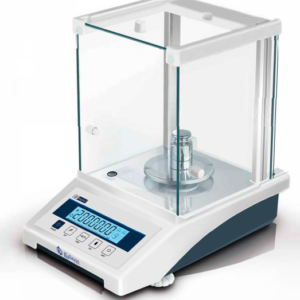Analytical balances are a special type of balance that offers very accurate measurements, because they have a system capable of measuring minute differences in mass. They are manufactured within a transparent box with doors to isolate it from certain factors that may affect its operation. Therefore, due to the need for extreme precision in the measurements carried out, they must be in specific rooms for handling, with controlled environmental conditions.
An analytical balance is commonly used to determine the mass of an object, it provides a high degree of precision in the order of 0.001 grams. For its correct operation, the analytical balance must be positioned under a specific environment and have controlled environmental conditions so that it does not suffer alteration in the absolute value of the weighing.
Applications of an analytical balance
Among the main applications of analytical balances we find:
- Preparation of standards.
- Formulation
- Determination of density.
- Interval weighing.
- Routine testing of micropipettes.
- Preparation of sample.
Analytical Balance Uses
Analytical balances are commonly used in laboratories as they are widely used to weigh ingredients in the manufacture of solutions, compounds, and drugs. It is recommended to calibrate them regularly, even more so when it is being operated for the first time, if it has been moved, after any leveling and after large variations in temperature or atmospheric pressure, modern analytical balances perform this function automatically. , when they detect any environmental variation.
Types of analytical balances
- Analog analytical balances: these are analytical balances based on mechanical measurement principles.
- Digital analytical balances: These are analytical balances that use electronic means for the measurement and transmission of data related to the weight of an object. They work through an electromagnetic system with a photocell that detects the position of the plate and an electromagnet in charge of balancing the force exerted by the load on the plate. They measure forces, so they must be calibrated to adapt to the gravitational intensity in the place where the weighing is carried out.
Correct operation of an analytical balance
For an analytical balance to function properly, certain basic care must be taken, such as, for example, always check the balance’s calibration, leave it plugged in and turned on to maintain the thermal balance of the electronic circuits, but always leave it in stand-by mode, avoiding the need for a new heating time. And finally, constant care must be taken with the weighing jar and pan, reading, calibrating, and maintaining the balance to ensure accurate weighing.
It is advisable to calibrate analytical balances periodically, especially when it is being used for the first time, if it has been moved, after any leveling and after large variations in temperature or atmospheric pressure, modern analytical balances perform this function, automatically, when they detect any environmental variation. HERE
At Kalstein we are MANUFACTURERS and we have innovative analytical balances at the best PRICES on the market. So we invite you to take a look HERE


